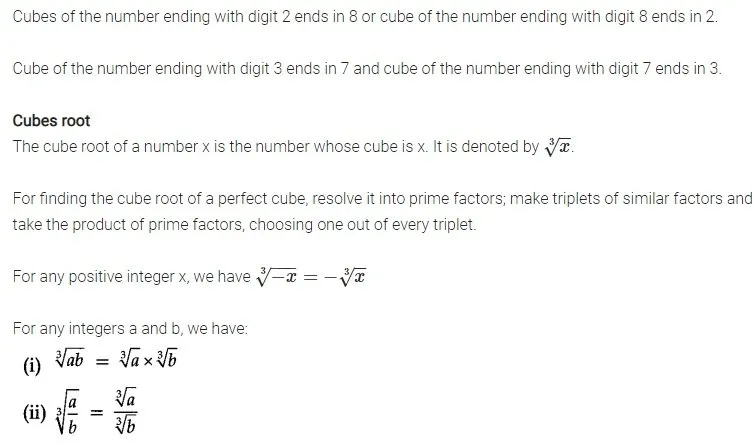Cubes
The cube of a number is that number raised to the power 3. If x is a number, then x3 = x × x × x.
A natural number n is a perfect cube if n = m3 for some natural number m.
The cube of an even natural number is even.
The cube of an odd natural number is odd.
The cube of a negative number is always negative.
The sum of the cubes of first n natural numbers is equal to the square of their sum.
i.e., 13 + 23 + 33 + ……. + n3 = (1 + 2 + 3 + …….. + n)2
Cubes of the numbers ending with the digits 0, 1, 2, 3, 4, 5, 6, 7, 8, 9 end with digits 0, 1, 8, 1, 7, 5, 6, 3, 2, 9 respectively. Here, cubes of numbers ending with digits 0, 1, 4, 5, 6 and 9 end with same digits.

Hardy-Ramanujan Number
Look at the following relations:
1729 = 1728 + 1 = 123 + 13
1729 = 1000 + 729 = 103 + 93
1729 is the smallest Hardy-Ramanujan Number (a number which can be expressed as a sum of two cubes in two different ways is known as Hardy- Ramanujan Number). There are infinitely many such numbers.
Few are 4104 (2, 16; 9, 15), 13832 (18, 20; 2, 24).
Cubes
Numbers obtained when a number is multiplied by itself three times are known as cube numbers or perfect cubes.
For example: 1, 8, 27, …, etc.
The cube of a natural number m is denoted by m3 and is expressed as m3 = m × m × m.
Thus, 13 = 1 × 1 × 1 = 1
23 = 2 × 2 × 2 = 8
33 = 3 × 3 × 3 = 27, and so on.
Some Interesting Patterns
If in the prime factorisation of any number, each prime factor appears three times, then the number is a perfect cube.
For example, 216 = 2 × 2 × 2 × 3 × 3 × 3 = 23 × 33 = (2 × 3)3 = 63 which is a perfect cube.
Smallest Multiple that is a Perfect Cube
Sometimes we have to find the smallest natural number by which a number is multiplied or divided to make it a perfect cube.
Cube Roots
The cube root is the inverse operation of finding the cube.
23 = 8 ⇒ 2 is the cube root of 8.
The symbol √ denotes the cube root. Thus, cube root 8 equal 2.
Cube Root Through Prime Factorisation Method
We express the given number into a product of its prime factors and make triplets (groups of three) of similar factors. Then, we take one factor from each triplet and multiply. The product so obtained gives the cube root of the given number.
Cube Root of a Cube Number
Steps
- Obtain the given number. Start making groups of three digits starting from the rightmost digit of the number.
- The first group will give one’s (unit’s) digit of the required cube root.
- Then, take another group. Find two closest cube numbers between which this group lies. Take the one’s place of the smaller number as the ten’s place of the required cube root.